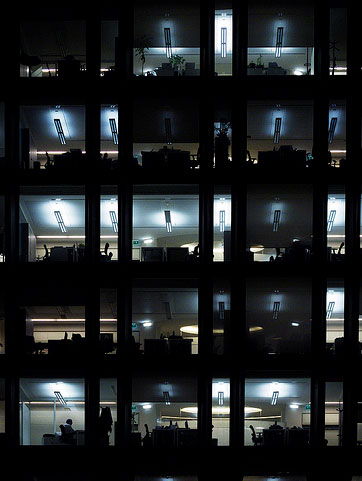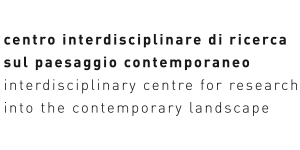La città e la sua ombra
The city and its shadow
(tratto da NB. Numero 1, Anno II – gennaio 2000 – aprile 2001)
Dagli scavi di via dell’Abbondanza a Pompei emergono, in un tratto di cinquecento metri, duecentottantacinque lampade per l’illuminazione notturna, mentre trecenonovantasei sono quelle collocate nei cinquecentosettantasei metri della seconda via cittadina. La strada maestra per Stabia, settecento metri di lunghezza, conta cinquecento lampade. Il Vesuvio coprirà tutto di cenere e lapilli, le vie delle città torneranno al calar della notte buie come il cielo, dentro le porte serrate, nel tentativo di lasciare fuori da sé i padroni del buio, i briganti, i barbari, i malintenzionati, i vagabondi. Tentativo vano. Mentre chi ha lavorato duramente di giorno raggiunge finalmente il riposo, vagano per le strade ubriachi e giovinastri, incuranti delle ronde; qua si accende una rissa, là scintilla la lama di un pugnale. La città ripete così il dualismo tra bene e male, tra luce e tenebre, tra giorno e notte. Il trionfo della ragione si chiamerà “illuminisimo”, il suo il “secolo dei lumi”. Il grande sforzo di illuminare le città alla fine del secolo XIX, prima con il gas poi finalmente con l’elettricità, è un tentativo di ricacciare indietro un male (l’irrazionalità, l’irregolarità) che la scienza positivista, codificando lo spazio e il tempo (i fusi orari, il metro e le unità di misura) crede di poter annullare. È una luce diversa da quella che Luigi XIV aveva collocato nelle strade di Parigi, che era un simbolo del potere come le luminarie che da sempre i regnanti avevano offerto in occasioni speciali ai loro sudditi. La luce dell’Ottocento è l’incarnazionee la pubblicità del progresso, un’illuminazione irradiata da un servizio a rete, alimentata e industrializzata dai tubi del gas e dai cavi della luce, costante, uniforme, centralizzata, scenografica. Una notte bianca. Mau- passant (Claire de lune): Tout était clair dans l’air léger, depuis les planètes jusqu’aux becs de gaz. Tant de feux brillaient là-haut et dans la ville que les ténèbres en semblaient lumineuses. Les nuits luisantes son plus joyeueses que les grans jours de soleil.
La luce artificiale è anche controllo, ordine pubblico, tentativo di contenere le classes dangereux dell’universo urbano. Reprimere quell’oscurità da sempre associata alla devianza, al pericolo, al rischio, in opposizione con le calvinistiche attività economiche che si svolgono “alla luce del sole”, nella società del lecito, di giorno. Il buio viene “colonizzato” dalla luce artificiale come la ferrovia ha colonizzato il West americano. Man mano che procede l’annessione al giorno di porzioni della notte, ormai illuminate, si creano nuovi insediamenti (come i carri dei coloni che seguivano la conquista del West): le fabbriche aperte di notte e rischiarate dalle lampade ad arco, gli edifici dei giornali illuminati in cui si prepara l’edizione dell’indomani, tram e treni che viaggiano con i fari accesi in quello che fu il buio. La giornata non è più sufficiente a contenere gli ambiti in continua espansione della vita produttiva e sociale, che debordano verso la notte.
Questo sconfinamento tuttavia – ed è il punto più importante – non è riuscito a cancellare la distinzione, di ordine culturale ed etico, fra attività diurne e notturne, fra eventi del giorno e della notte. Non poteva uccidere la propria ombra. La maggiore praticabilità della metropoli nelle ore in cui i lavoratori diurni cercano il riposo, fatta di luce, trasporti pubblici, negozi e ritrovi aperti, è servita a traghettare nel mondo notturno molto del bisogno di altro, di trasgressione, di ludus, di sperimentazione che un assetto fordista, da etica protestante, dell’organizzata città diurna non può esprimere. Ha favorito, piuttosto che reprimere, l’ombra.

La colonizzazione della notte è sostanzialmente fallita, come è fallita la pretesa positivista, mascherata da scienza, di dominare lo spazio e il tempo in modo totalitario. Nell’era della mobilità di massa, in cui milioni di persone e di giovani non lavorano in modo così stancante da non poter uscire di notte (o non lavorano affatto) la notte resta il dominio dell’altro. Nel territorio della notte si addensano i controluoghi, dove tutti gli altri luoghi reali che si trovano all’interno della cultura vengono al contempo rappresentati, contestati e sovvertiti (Foucault). Si tratta di varcare una soglia, di andare “di là”, attraverso speciali riti ingressivi, verso una notte che sempre più si connota come un “evento unico” che talvolta riesce a prendere di contropiede il giorno, effettuando sortite, colonizzando a sua volta porzioni del tempo diurno come il week end, inglobato fra la notte del venerdì e quella della domenica. Lo stesso teatro urbanistico, architettonico, sociale comprende la città del giorno e quella della notte. Due metà, due polarità; una duplice e contraddittoria offerta di luoghi, di culture, di forme del consumo.
[english]
(from NB. Issue 1, Year II – january 2000 – april 2001)
The excavations in via dell’Abbondanza in Pompei, covering a stretch of five hundred metres, 285 lamps for night lighting have emerged; 396 have come to light in the 576 metres of the second street in the city. The main road to Stabia, 700 metres long, has 500 lamps. Vesuvius covered all this with cinders and lapilli, the streets went back to being as dark as night, behind closed doors, in an attempt to shut out the lords of darkness, brigands, barbarians, wrong–doers, vagabonds. All in vain. While those who worked hard all day finally take their rest, it was drunks and louts, who wandered the streets, heedless of the watch: here, a brawl would break out, there a dagger would flash.
It is thus that the city repeats the dualism between good and evil, light and darkness, day and night. The triumph of reason is defined as “enlightenment”, its century is the “that of light”. The great effort to illuminate the city at the end of the 19th century, first with gas then finally with electricity, aimed at warding off evil (the irrational, the irregular) which positivistic science, codifying space and time (time zones, the rule and units of me- asurement) thought it could eliminate. It was a different light to that which Louis IV had provided the streets of Paris with, a symbol of power like the illuminations which rulers had always offered on special occasions to their subjects. This 19th century light was the incarnation, the advertising, of progress, the lighting of the grid, fed and industrialised by gas tubes and light cables, constant, uniform, centralised, scenic. White nights. Maupassant (Claire de lune); Tout était clair dans l’air léger, depuis les planètes jusqu’aux becs de gaz. Tant de feux brillaient là haut et dans la ville que les ténèbres en semblaient lumineuses. Les nuis luisantes son plus joyeusses que les grands jours de soleil. Artificial light is also control, law and order, an attempt at keeping in check the dangerous classes of the urban universe.
Repressing that obscurity which has always been associated with deviancy, danger, risk, in contrast to the economic Calvinistic activities which are carried out “by the light of day”, in the society of the legitimate, the day. Darkness was “colonised” by artificial light, like the railway colonised the American west. Little by little, as the annexation of portions of the night – now lit up – by the day, took place, new settlements were created (like the wagons which followed the conquest of the west): factories open at night and lit up by arc lamps, the illuminated buildings of newspapers in which the next day’s edition is being prepared, trams and trains, illuminated, passing through what was once darkness. The day is no longer sufficient to contain the spheres of social and productive life, in continuous expansion, which spill over into the night. However, this going beyond the limits – and this is the most important point – was not able to erase the distinction, of a cultural and ethical order, between daily and nightly activity, between the events of the day and those of the night. It could not eliminate its own shadow.The greater practicability of the metropolis in those hours in which day workers seek relaxation, the hours of light, public transport, shops and meeting places in the open, meant that much of the need for something else, tran- sgression, fun, experimentation, was carried over to the nocturnal world – those things that the industrialied world of the protestant work ethic, that of the organised daily city, could not express. It favoured, rather than repressed, the shadows.
The colonisation of the night has, on the whole, failed, as has the positivist claim, disguised as science, of dominating space and time in a totalitarian manner. In an age of mass mobility, in which millions of people and particularly young people do not work so hard that they cannot go out in the evening (should they work at all) the night remains the dominion of the other. It is in the territory of the night that the “counterplaces” are concentrated, where all the other real places to be found within culture are represented, challenged, subverted, all at the same time (Foucault). It is like crossing a threshold, going “beyond”, by means of ingressive rites, towards a night which is increasingly a “unique event”. It some- times manages to catch the day off-guard, carrying out sorties, colonising in turn portions of daytime like the weekend – the night of Friday and that of Sunday. The urban, architectural, social, theatre includes the city of the day and that of the night. Two halves, two polarities; one double and contradictory offer of cultures, forms of consumption.

